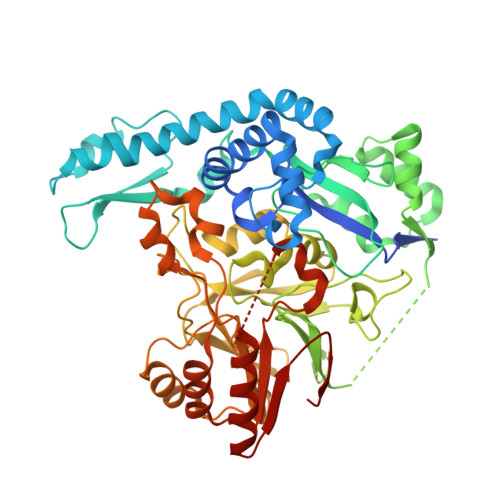A Carboxylate Shift Regulates Dioxygen Activation by the Diiron Nonheme beta-Hydroxylase CmlA upon Binding of a Substrate-Loaded Nonribosomal Peptide Synthetase.
Jasniewski, A.J., Knoot, C.J., Lipscomb, J.D., Que, L.(2016) Biochemistry 55: 5818-5831
- PubMed: 27668828
- DOI: https://doi.org/10.1021/acs.biochem.6b00834
- Primary Citation of Related Structures:
5KIK, 5KIL - PubMed Abstract:
The first step in the nonribosomal peptide synthetase (NRPS)-based biosynthesis of chloramphenicol is the β-hydroxylation of the precursor l-p-aminophenylalanine (l-PAPA) catalyzed by the monooxygenase CmlA. The active site of CmlA contains a dinuclear iron cluster that is reduced to the diferrous state (WT R ) to initiate O 2 activation. However, rapid O 2 activation occurs only when WT R is bound to CmlP, the NRPS to which l-PAPA is covalently attached. Here the X-ray crystal structure of WT R is reported, which is very similar to that of the as-isolated diferric enzyme in which the irons are coordinately saturated. X-ray absorption spectroscopy is used to investigate the WT R cluster ligand structure as well as the structures of WT R in complex with a functional CmlP variant (CmlP AT ) with and without l-PAPA attached. It is found that formation of the active WT R :CmlP AT -l-PAPA complex converts at least one iron of the cluster from six- to five-coordinate by changing a bidentately bound amino acid carboxylate to monodentate on Fe1. The only bidentate carboxylate in the structure of WT R is E377. The crystal structure of the CmlA variant E377D shows only monodentate carboxylate coordination. Reduced E377D reacts rapidly with O 2 in the presence or absence of CmlP AT -l-PAPA, showing loss of regulation. However, this variant fails to catalyze hydroxylation, suggesting that E377 has the dual role of coupling regulation of O 2 reactivity with juxtaposition of the substrate and the reactive oxygen species. The carboxylate shift in response to substrate binding represents a novel regulatory strategy for oxygen activation in diiron oxygenases.
Organizational Affiliation:
Department of Chemistry, University of Minnesota, Minneapolis, Minnesota 55455.

















